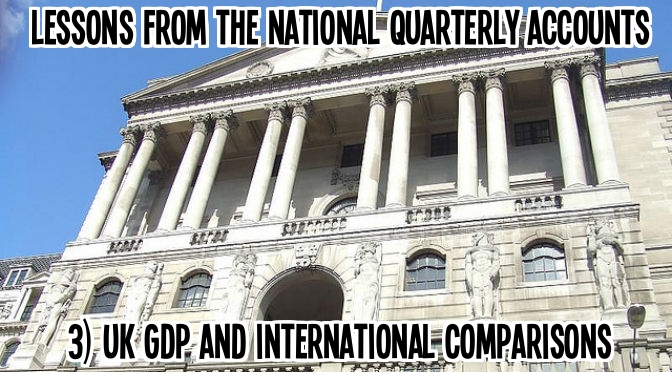UK GDP and international comparisons
Following our previous analysis of the household savings rate and real disposable income, we continue our series of articles analyzing the 2013 quarterly national accounts, published on the Office for National Statistics website on 28th March 2014.
We summarized the key findings of the report in the prior articles as follows:
- UK gross domestic product (GDP) in volume terms was estimated to have increased by 0.7% between Q3 2013 and Q4 2013.
- UK GDP is estimated to have increased by 1.7% in 2013, compared with 2012.
- Between Q4 2012 and Q4 2013 GDP in volume terms increased by 2.7%.
- The households’ saving ratio was estimated to be 5.1% in 2013, compared with 7.3% in 2012.
- UK GDP in current prices was estimated to have increased by 1.6% between Q3 2013 and Q4 2013.
However, today I want to focus on something beyond the headlines. On page 21-23 of the report, we find some great international comparisons of GDP.
From the headline above, we see that:
Between Q4 2012 and Q4 2013 UK GDP in volume terms increased by 2.7%
But, how does this compare to other countries / regions?
What is GDP?
GDP stands for gross domestic produce.
GDP is an estimate of total economic activity. It is constructed by balancing the estimates from the output, income and expenditure approaches to measuring GDP which in theory are all equal.
Data used in this article will have been seasonally adjusted (SA) with seasonal effects removed to allow comparisons over time. Estimates are given in chained volume measures (CVM), sometimes known as real terms, with the effects of inflation removed.
How has GDP changed in the UK over time?
Since 1988, UK GDP has increased by, on average, 2.3% per annum:
In the UK, we have noted the following GDP volume “growth” over the past 6 years:
- 2008 – (-4.3%)
- 2009 – (-2.5%)
- 2010 – 1.7%
- 2011 – 1.1%
- 2012 – 0.2%
- 2013 – 2.7%
We can see from this that, following the recession in 2008/2009, the UK GDP figures have been coming back and, in 2013, showed above average growth for the first time since 2007.
How has UK GDP changed compared to other countries?
Let’s look at how this compares to other countries:
Gold medal.
In 2013, the UK saw a volume increase of 2.7%. This slightly exceeds the GDP growth rate noted in other major economies (2.5% for Japan & USA). In comparison to the rest of the Eurozone, the UK GDP is looking pretty impressive.
Looking further back, to 2011 for example, the US growth exceeds that of the UK with average annual growth of 2.1% compared to 1.3% in the UK.
How did different countries deal with the recession?
Given the figures noted above, we saw that the UK suffered a decrease in GDP in both 2008 and 2009, the decline totaling 6.8%. Since 2010, the UK have noted increases totaling 5.7%, showing that the UK has not yet “recovered” from the recession.
What about other regions?
Japan and the EU have still not recovered and, in fact, are still almost 2% below where they were in 2008.
This is explored further in the moneystepper article: Is the Eurozone crisis over?
However, the US only noted their decline in Q4 2008 and had recovered by Q3 2010 (less than 2 years later).
There may be many reasons why this is the case, but many people argue that quantitative easing has had significantly different impacts in the UK and US. I would disagree.
The UK, have added £375bn in quantitative easing (approx. $624bn).
The US have performed quantitative easing over three stages:
- QE1 – $1,725 bn ($1.25 trillion in mortgage-backed securities, $300 billion in Treasury bonds and $175 billion in federal agency debt)
QE2 – $600 bn - QE3 – $1,430 bn to date
Therefore, up to March 2014, US quantitative easing totals $3,755 bn, and its not finished yet.
In 2012, the GDP of the UK was $2,435 bn. The GDP of the US was $15,680 bn.
This means that the UK have added 25.6% of their 2012 GDP into their economy. The US, on the other hand, have added 23.9% of their 2012 GDP into their economy. So, whilst the US still have more to come, they have in fact pumped a smaller proportion of money back into their economy that the UK.
What does this mean for me?
What does this mean for individuals?
Well, it is generally accepted that good GDP growth rate is positive for the inhabitants of a country (unless there is widespread corruption in the country).
Therefore, after a few tough years since 2008, the 2013 2.7% increase will hopefully be a sign of things to come. However, the concerns that these figures are artificially inflated due to quantitative easing may weigh down on this prospective growth.





The good news is that it has been a steady increase over the past couple of years. I think that the worst is behind us. But with that said, I think it’s a long race, not a sprint, so we will only continue to see slow steady increases of GDP year over year.
Very interesting study and statistics from our friends across the pond. I was surprised at the 2.7 leadership position. Since we are all so interconnected these days, your success will likely bring us success. Got a lot out of your post, so thanks.